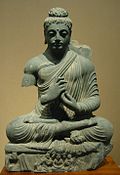
Back كاندراكيرتي Arabic كاندراكيرتى ARZ Чандракирти Bulgarian চন্দ্রকীর্তি Bengali/Bangla དཔལ་ལྡན་ཟླ་བ་གྲགས་པ་ Tibetan Chandrakirti German Ĉandrakirtio Esperanto Chandrakirti Spanish Chandrakirti Basque Chandrakîrti French
Chandrakirti | |
|---|---|
 traditional Chinese: 月稱; pinyin: Yuèchēng; Japanese: Gesshō; Tibetan: ཟླ་བ་གྲགས་པ་, Wylie: zla ba grags pa, Lhasa dialect: [tàwa ʈʰàʔpa] | |
| Personal | |
| Born | c. 600 CE South India |
| Died | c. 670 CE |
| Religion | Buddhism |
| School | Madhyamaka |
| Education | Nalanda |
| Part of a series on |
| Buddhist philosophy |
|---|
 |
|
|
Chandrakirti (IAST: Candrakīrti; Sanskrit: चंद्रकीर्ति; traditional Chinese: 月稱; c. 600 – c. 650, meaning "glory of the moon" in Sanskrit) or "Chandra" was a Buddhist scholar of the Madhyamaka school who was based out of the monastery of Nalanda. He was a noted commentator on the works of Nagarjuna (c. 150 – c. 250 CE) and those of his main disciple, Aryadeva. He wrote two influential works on Madhyamaka, the Prasannapadā and the Madhyamakāvatāra.[1]
Chandrakirti does not seem to have been very influential during the 7th to 10th centuries, and his works were never translated into Chinese.[2][1] However, by the 11th and 12th centuries, his work became influential in the north, especially in Kashmir and in Tibet. Over time, Chandrakirti became a major source for the study of Madhyamaka philosophy in Tibetan Buddhism.[1] Chandrakirti's work was especially promoted by Tibetans like Rendawa Zhönnu Lodrö and his student Tsongkhapa as a way to counter the widespread influence of the Uttaratantra, and the shentong views associated with it.[3]
As noted by Kevin A. Vose, Chandrakirti is seen by many Tibetan Buddhists as offering "the most thorough and accurate vision of Nāgārjuna's emptiness, which, in turn, most fully represents the final truth of the Buddha's teaching."[4] He is considered by Tibetans to be the main exponent of what they term the "Prāsaṅgika" sub-school of madhyamaka. However, this doxographical categorization only arose in Tibet during the 12th century.[4]
- ^ a b c Buswell & Lopez 2013, Entry for Candrakīrti.
- ^ Vose 2015, pp. 3-4.
- ^ Wangchuk, Tsering (2017). The "Uttaratantra" in the land of snows: tibetan thinkers debate the centrality of the Buddha-nature treatise. Albany (N.Y.): SUNY Press. pp. 109–112. ISBN 978-1-4384-6465-7.
- ^ a b Vose 2015, pp. 2, 6.